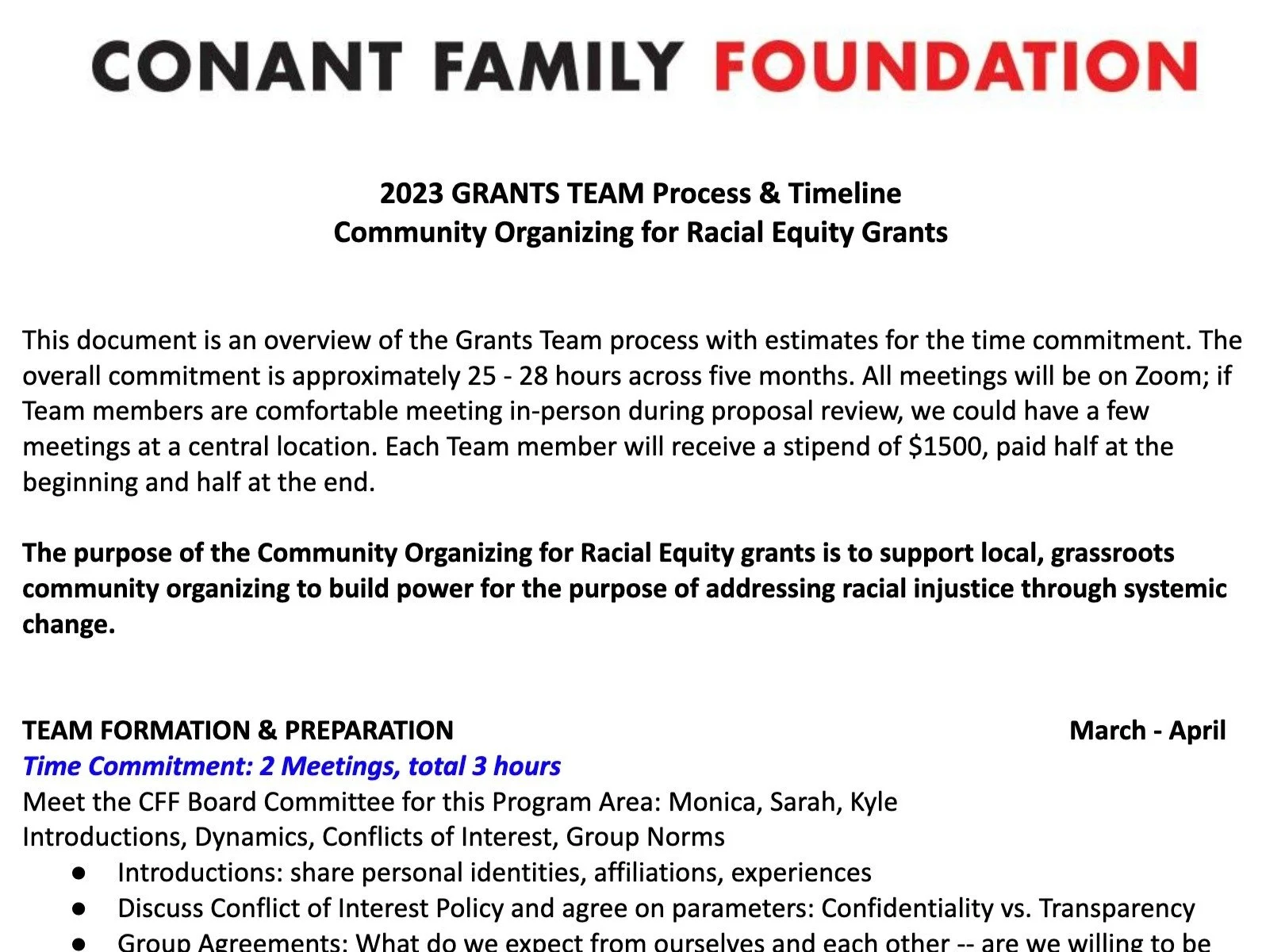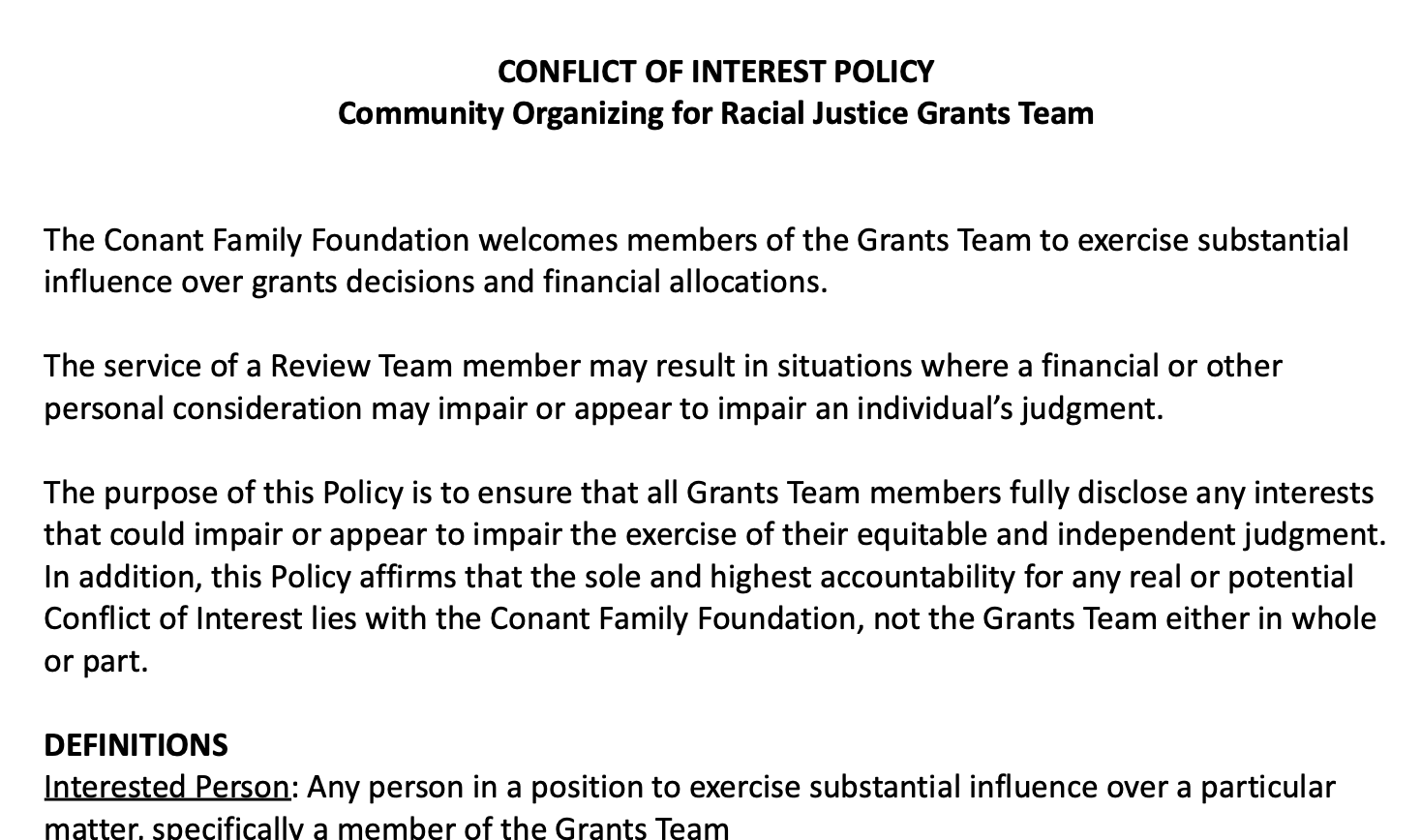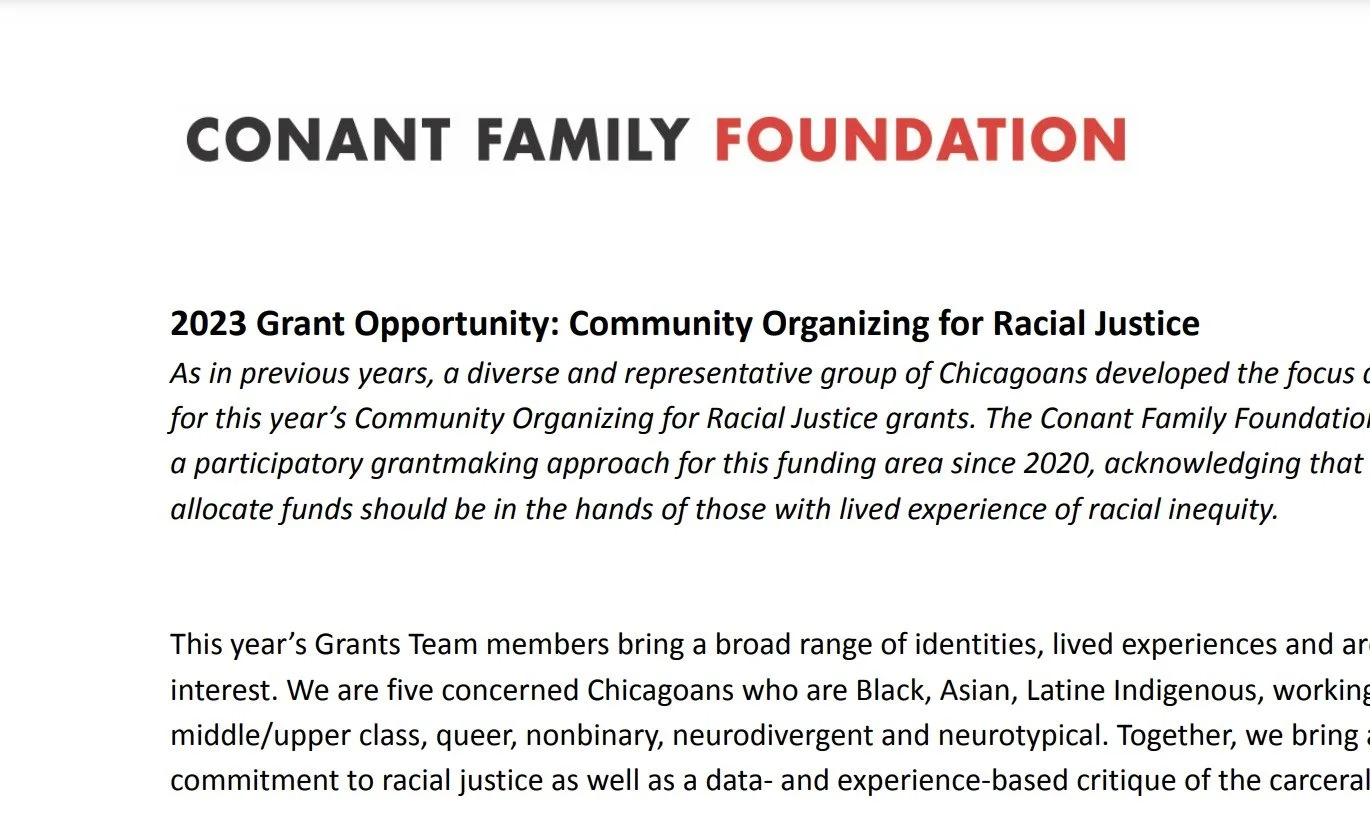Shifting
Power
Participatory
Grantmaking
Like most other family foundations, the Conant Family Foundation has an all-white, all-family, wealth-privileged board. While they are professionals in multiple fields, they aren't experts on all issues.
Sometimes the wisest decision a foundation can make is to move grantmaking decisions to those closer to the issue.
Participatory Grantmaking engages people with lived experiences and greater proximity to racial injustice to identify funding priorities and allocate grant money.
What follows is an overview of the 2023 Grants Team process. It has links to documents you can adapt. Most importantly, it includes messages from Team members themselves, describing their process and intentions.
Interested in trying participatory grantmaking? Let us know how we can help!
Demystifying Participatory Grantmaking
Step by Step Implementation Guide
How much money will the participants be allocating? Will the grants be one-year or multi-year?
Include funds to compensate participants. We provided $1500 each, but will likely increase this amount.
Decide who will facilitate the process. If staff, do they have the experience and time available? If a consultant, factor in additional fees.
Conant Family Foundation's executive director facilitates our PG process.
Consider funds for convenings or other in-person gatherings
A. Create the Budget
Be clear about the Grants Team's tasks. Write out the Process and Timeline, estimating how much time each step will take.
This document allows prospective Team members to see what they will be doing and when.
It's also an important tool for the facilitator, as it specifies the staff roles and responsibilities, too.
Having learned from previous rounds of participatory grantmaking, Leslie increased the specificity of the workplan and expanded the timeline in 2023 to allow more time for planning, reviewing and evaluating the process.
B. Develop a Workplan
We prioritized Chicagoans who understood community organizing, had demonstrated commitments to racial justice, and who reflected the demographics of Chicago.
Throughout the years we have requested nominations from a leadership program called Chicago United For Equity, Crossroads Fund's Giving Project, and a Block Club Chicago, a local independent news outlet. Now we ask past participants for nominations, too.
This cycle, we Interviewed eight nominees and invited five to join the Team.
Past teams have been as big as 10 people but more people makes it harder to schedule meetings. Consistent participation is key.
C. Assemble the Team
Everyone has biases, including foundation board members! But there's a difference between bias and personal interest.
Just as foundations beware self-dealing, participants are asked to disclose any financial relationships to nonprofit community organizing groups.
We discuss the perception of a potential conflict of interest and provide opportunities for disclosure, recusal and abstention.
The Conflict of Interest Policy ensures transparency and accountability,
Team members can bring their insights and experiences into the process openly.
Knowledge about the real work of an organization is an asset, not a liability.
D. Address Conflicts of Interest
The Conant Family Foundation board determined the program area: Community Organizing for Racial Justice.
The Grants Team has the privilege and responsibility of identifying the focus and priorities within those broad parameters.
As facilitator, Leslie provided an orientation on grantmaking. First rule: Be specific about what you want to fund so that groups can determine if it is worth applying.
Then, figure out what information you will need from applicants to decide if they should (or should not) receive a grant.
Over several meetings, the Team agreed on a single focus area, funding parameters, and outlined a decision-making process.
Leslie shaped the information into a Guidelines document and sent it to the Team for edits and approval.
E. Identify Funding Priorities
Before a single LOI or proposal came in, the Team discussed criteria for evaluating applicant organizations.
They co-created a Review Rubric that everyone used as a guide. It included summative as well as analytical questions.
While the specific criteria in the Review Rubric must be tailored to the specific funding focus, this kind of tool can be customized for any funding focus.
When the applications came in, the Team reviewed a few LOIs together to "test" and refine the Rubric.
F. Clarify Selection Criteria
Having developed mutual trust and respect through the process, the Team deliberated and came to unanimous decisions. Their final selections were guided by their intention to create a multi-dimensional cohort.
Staff handled the due diligence of confirming IRS 501c3 designations, and plotted applicants on a map to visualize geographic dispersement.
As always, there wasn’t enough money to fund all of the outstanding organizations.
The most difficult decisions are always the final few, where the deliberation switches from which group to fund to which group not to fund.
Every Grants Team wants to know the ‘formula’ for making these decisions, assuming foundations have the answer.
Instead, Leslie returned to the criteria and intentions they identified earlier in the process. They continued discussing and voting until agreement was reached.
These decisions, like everything else in philanthropy, are simply choices. What matters most is who makes them.
G. Allocate Grant Funds
The Grants Team requested that staff connect with all groups that applied, especially those who were declined. This was their message:
We selected a cohort of grantee groups that reflect following attributes. Together, they:
Intentionally apply an abolitionist framework and have a clear pathway for deepening the implementation of their framework
Build deep community power and center the leadership of those most impacted abolitionist work across Chicago
Support mutual aid structures that build community self-determination and make way for a future where wealth is redistributed and shared in community, not extracted for the benefit of others
Support a range of abolitionist organizing addressing prisons, policing, surveillance, housing, gender-based violence, militarism, and the immigration system
We moved more of our resources to smaller organizations and trusted that smaller organizations can and will manage significant growth to their budget
H. Communicate Decisions
One of the most rewarding aspects of this work is learning from the process.
Every Team member is invited to provide ‘brutally honest’ feedback through an anonymous survey.
It is then our responsibility to make changes that will improve the experience for the next Grants Team.
Accept critique as a gift, because it truly is!
The feedback we have received has been far from neutral.
The positive has far outweighed the negative, but that first Team was absolutely right when they said we weren’t paying them adequately for their time and expertise.
Reading through a dozen grant applications takes time — more time than we estimated!
More than one participant compared the experience to realizing the Wizard of Oz was just a single man behind a curtain. Foundations may seem like institutions to outsiders, but inside it is just a small group of people.
Let’s make sure that group includes people closest to the issues we seek to address.
I. Learning & Improving
SAMPLE DOCUMENTS
If you found this webpage helpful, check out the Fund for Shared Insight’s Participatory Philanthropy Toolkit






